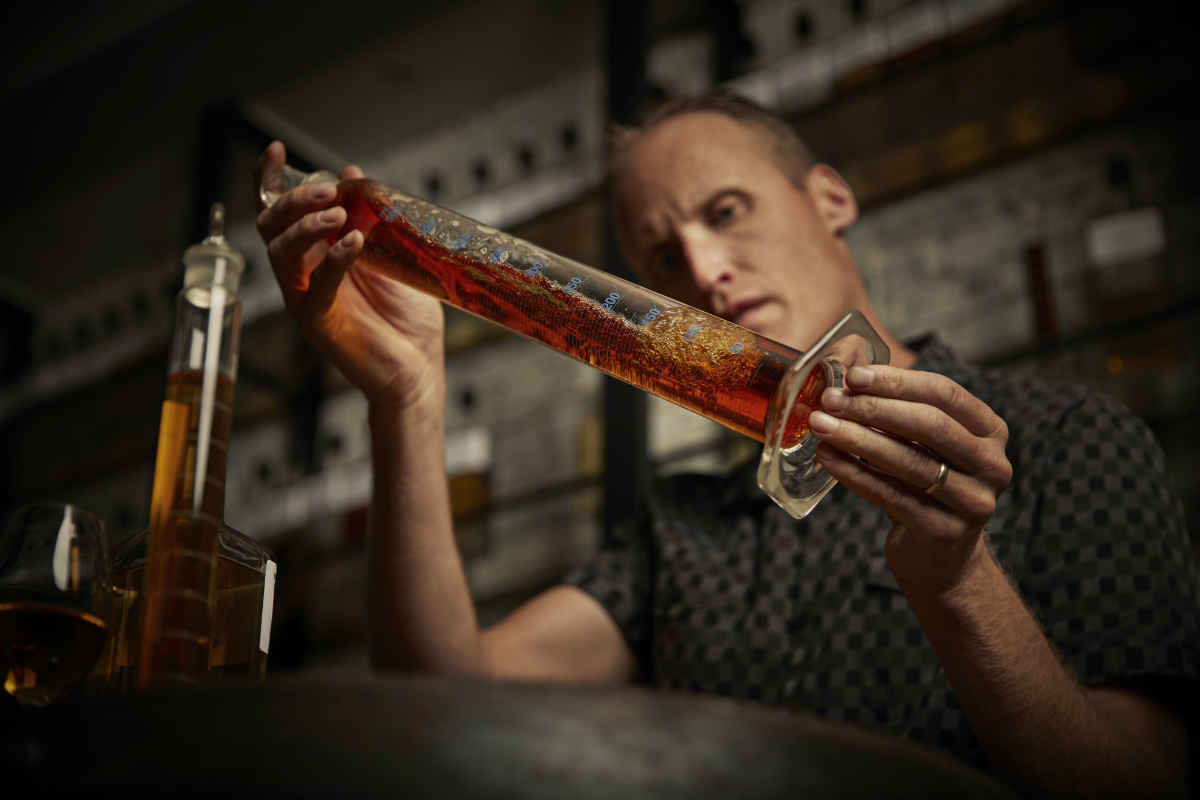That’s how Master Blender Don Livermore begins a blending exercise held at the Hiram Walker Distillery in Windsor, Ontario. Livermore is as Canadian as they come—his royalist ancestors emigrated to the country following the American Revolution—and affably polite. Yet he’d be a hard man to argue with on this point; he’s responsible for brands including Lot 40, Pike Creek, JP Wiser’s, and Gooderham & Worts. He even holds the rare Ph.D in brewing and distilling.
In short: Don Livermore might know more about Canadian whisky than any other living soul. And on this afternoon, I’m about to get my own lesson in blending from the doctor, alongside a handful of other journalists.
The Blending Exercise
Tables have been pushed together in the center of the room to form a cross-shape, and on their surface, whisky bottles and their attendant sample glasses sit in a sweeping X formation. What looks like a game of dominos played with whisky is a typical workstation for the Master Blender. Livermore commands one of North America’s largest distilleries and its warehouse with 1.6 million barrels of whisky. A great deal of his working day involves tasting the whisky at his disposal and deciding what makes it into a blend.
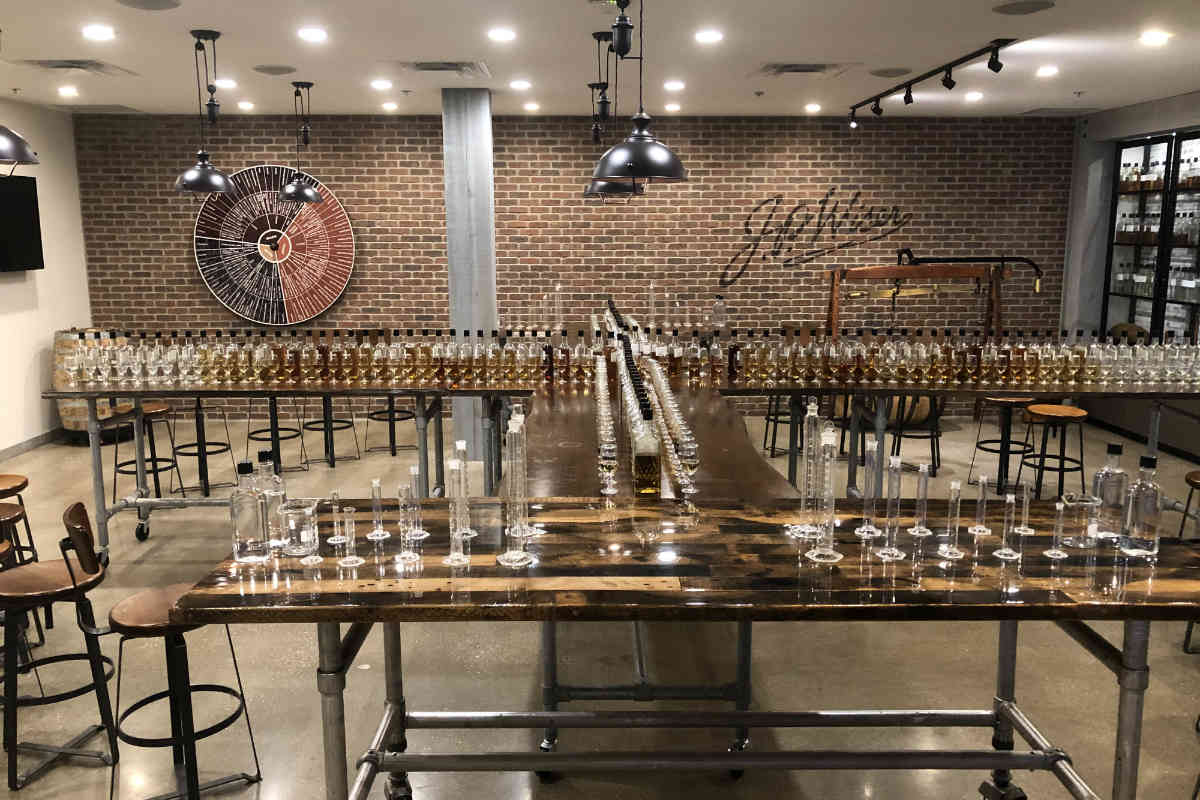
Hiram Walker
And now I’m about to do the same, minus the Ph.D, work experience, and virtually any other qualifying factor.
But first: the matter of what Canadian whisky is, and what it isn’t. It’s true that Canadian whiskies can include other, non-whisky spirits in the blend—but not neutral grain sprits, as Livermore emphatically points out. What Canadian whisky can include are wines or other distilled spirits aged for a minimum of two years, so long as they do not make up more than 9.09% of the blend (a precedent set by Hiram Walker himself, who used prune wine and Jamaican rum in his blends).
For this exercise, we’ll be picking from the whisky smorgasbord to create our own blend in a roughly 250ml flask. To decode the label of each sample, Livermore clues us into the house lingo: “star” indicates column-distilled, “special” indicates pot-distilled, and “star special” indicates that the spirit was first column-distilled and then pot-distilled. For instance, a “Rye Star” is a column-distilled rye whisky, and “Rye Star Special” is a column-distilled then pot-stilled rye whisky, etc.
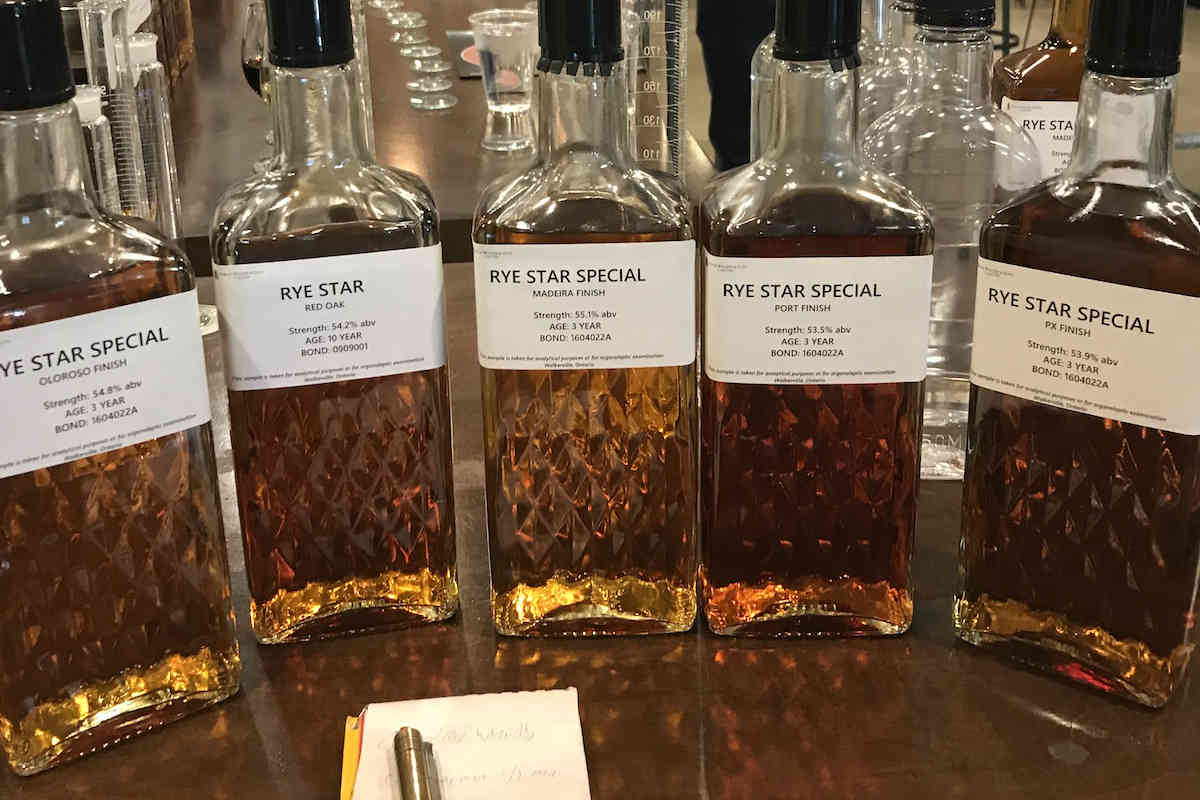
Eric Twardzik
Before blending, we sniff. The domino-line begins with unaged whiskies, the first of which is Corn Star, described by Livermore as “the closest thing we make to moonshine,” with a smell not unlike cauliflower. Next is corn, simply marked DD—“double-distilled”—which Livermore cites as an essential building block in his whiskies.
“Whisky is like making a pizza. The DD is your pizza dough,” he says.
The third glass encountered is also a DD, but this time it’s rye, with an oily, more characterful nose. Up next is Rye Star Special, which is essentially Lot 40 before it’s been aged. Other grains follow: Barley Star, Barley Star Special, Wheat Star, and so on. While the terminology can become repetitive, the nose of each sample is distinct.
“Changing your grain or changing your distillation method can change your flavor. If there is one point I’d like to drive home, that would be it,” Livermore says.
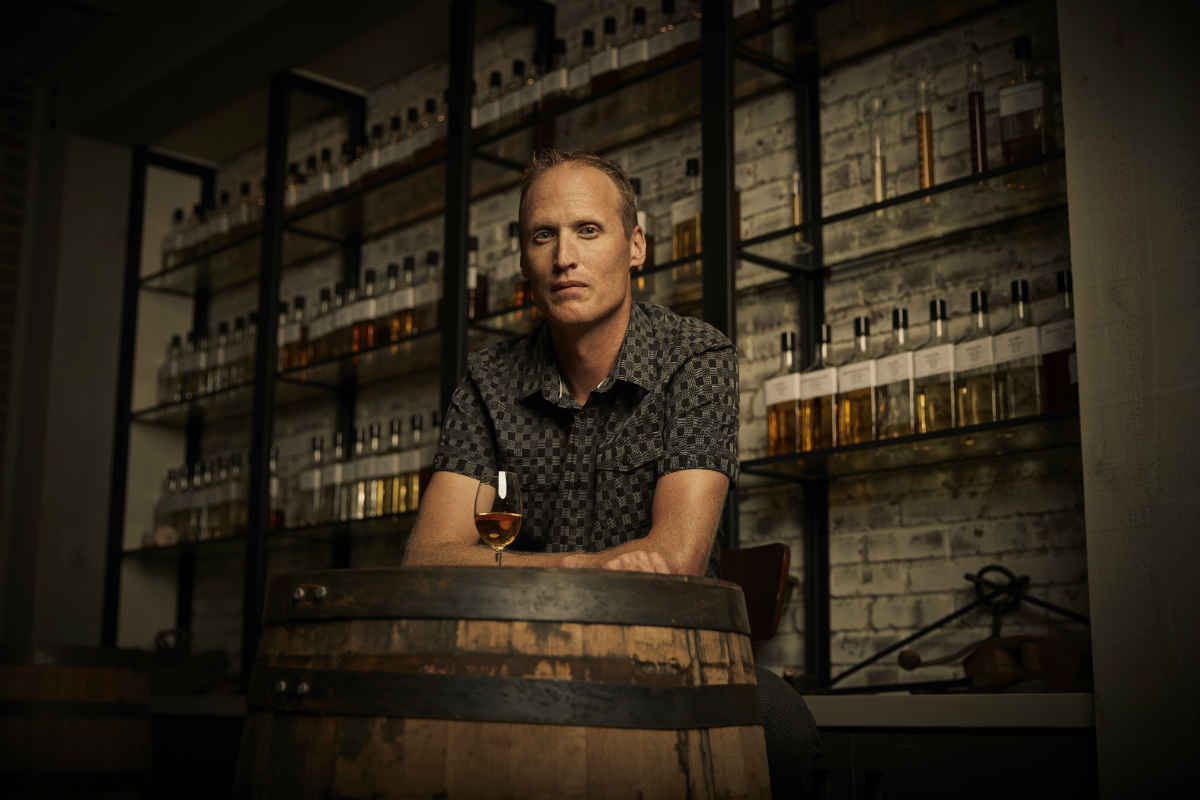
Don Livermore / Hiram Walker.
Soon we’re in aged territory, picking up DD’s ranging from a 3-year to an 18-year. These are still considered base whiskies, but then the wood gets funky: there’s a DD aged in new oak beside the same spirit aged in a re-charred barrel. The next 20 whiskies are all barrel-finishes, 10-year-old whiskies finished in bourbon barrels, rum barrels, brandy barrels, and more. Livermore highlights the French oak finish as a popular ingredient, thanks to its vanilla character.
Also included are “barrel inserts.” The barrels that held these whiskies were burned in specific ways to induce certain flavors: there’s an oak insert, a sweet insert, a smoky insert, and so on. I find myself enjoying the smoky insert for its campfire aroma.
Changing your grain or changing your distillation method can change your flavor.
Wine-barrel finishes are also represented; we spot a sherry finish, an oloroso finish, and a madeira finish among others. Like the other barrel-finishes, each is filled with DD, Livermore’s “pizza dough.”
“When we do finishing in the base whisky, you really get an appreciation for what the barrel is doing,” Livermore says.
I ask Livermore if there are any barrel-finishing experiments he hasn’t yet done but would like to try. He responds by admitting one of his failures.
“There’s some mistakes I haven’t put on the table here. I have a beer barrel finish that smells like a frat party.”
Lastly, we hit the stretch of samples that Livermore, in a sudden switch of food metaphors, refers to as “toppings” for a hypothetical sandwich. Among them are rye whiskies that he likens to jalapenos on a Subway sandwich: Rye Star, Rye Special, Rye Star Special French Oak, etc. The final three samples aren’t whiskies at all, but the type of spirits that qualify for the 9.09% rule: a sherry, a port wine, and a bourbon.
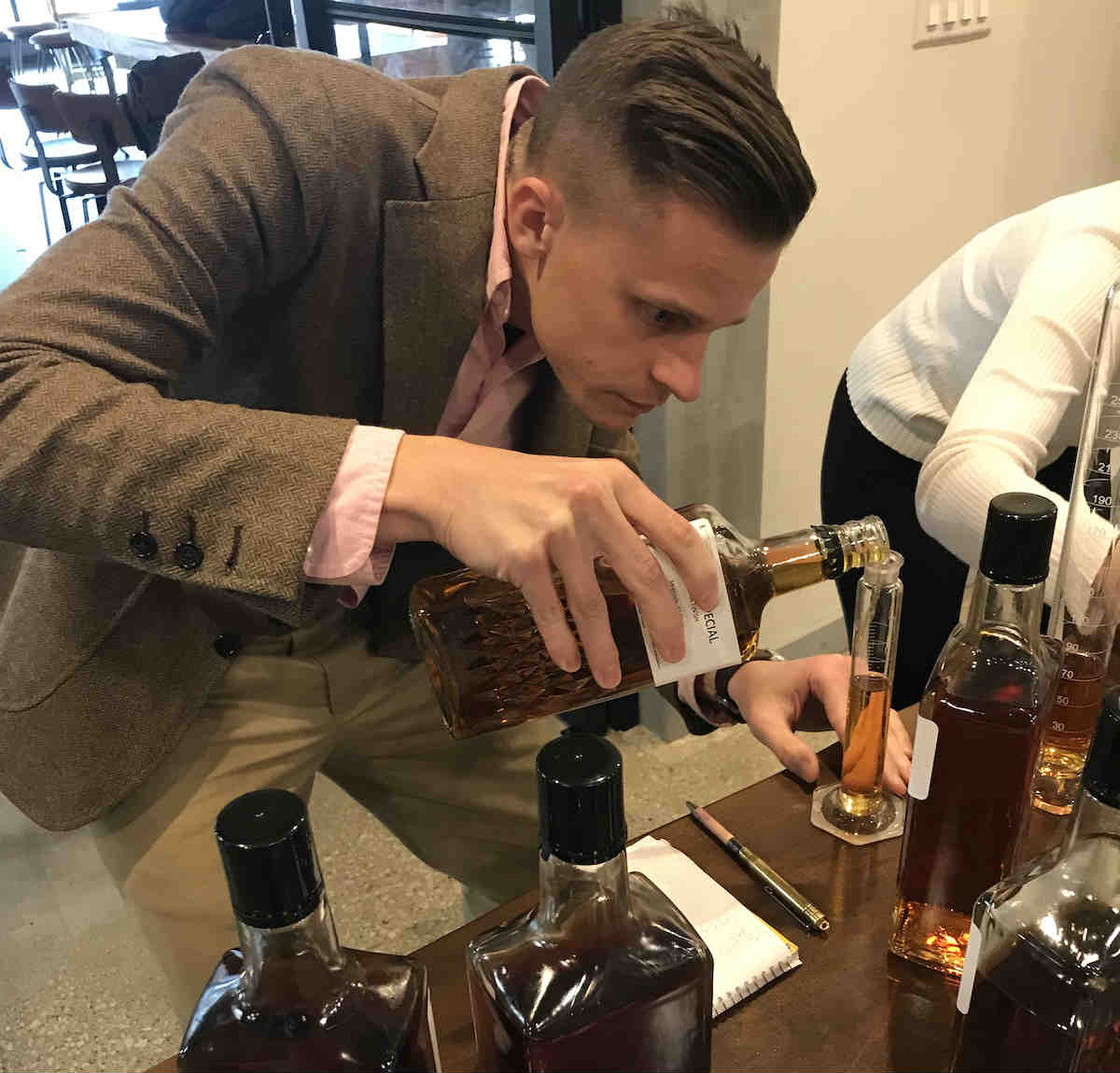
Eric Twardzik blends some whisky.
After some deliberation, I select the bottles for my blend. I bring my selections to Livermore, who plugs them into a spreadsheet on his computer and calculates a sound ratio. My blend will be 32% Rye Star Red Oak, 17% Rye Star Special Madeira, 17% Rye Star Special PX, 17% Rye Star Special Oloroso Sherry, and 17% Rye Star Special Port. I carry the bottles to a blending station at another table, where I carefully measure out the precise milliliters for each in a beaker before adding them to my flask, which gets a quick shake with its cap twisted on tight to complete the process.
The Taste Test
Like an anxious grade-schooler hoping to have their art project validated by a teacher, I bring the blend to Livermore. The Master Blender of Hiram Walker sips my creation, winces slightly, and emits an involuntary “oof.” Then he explains where I went wrong.
The blend needs more foundation. My own tasting indicated that something was off; it was hot and astringent, with too many divergent wine flavors and nothing solid to cling to. Livermore suggests I ditch Rye Star Special Red Oak for his favored Rye Star Special French Oak, boost that whisky’s share of the blend to 52%, and drop all the other wine finishes to 12%.
I believe Canadian whisky is the most innovative, creative, and adaptable style of whisky there is.
Take two is a vast improvement: now my blend has the robust body to match its varied finish.
Before we depart, Livermore shares a few of his non-whisky-related mistakes with us. Years ago, he decided to visit Winnipeg in February (his first mistake) for a whisky festival and agreed to appear on local television for a 6:45am interview the following morning (his second mistake).
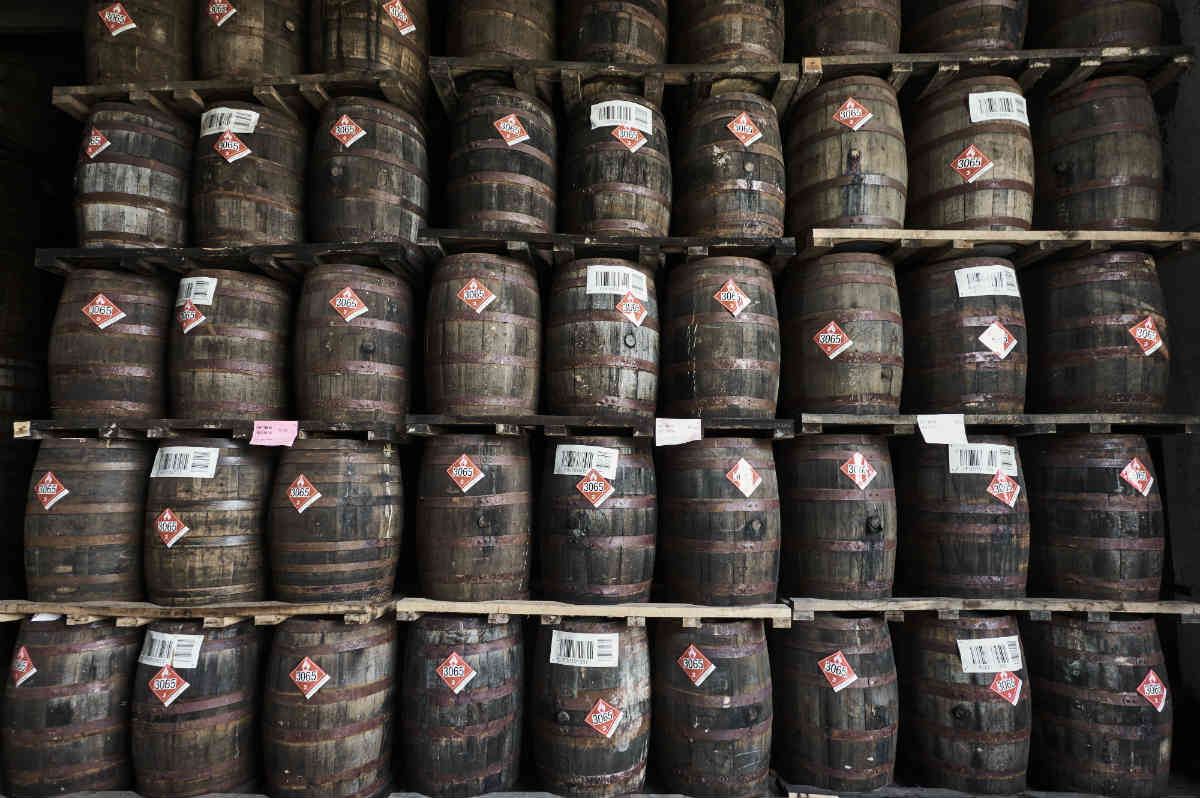
Hiram Walker Barrels / Hiram Walker
On TV, a sleep-deprived Livermore was hit with a question he hadn’t prepared for: what makes Canadian whisky better than scotch or Irish whiskey?
“It came to me in that moment and I answered, I believe Canadian whisky is the most innovative, creative, and adaptable style of whisky there is. All we have to do is be native grain, fermented, aged, and distilled in Canada, aged in a wooden barrel less than 700 liters for a minimum of three years, and then bottled at 40% alcohol; that’s it. They don’t tell me I have to use a mash bill. They don’t tell me how to distill it; column still, pot still, my choice. They don’t tell me the barrel type I have to use. New wood, used wood, wine barrels, it doesn’t matter. That makes Canadian whisky diverse. Isn’t that Canada?”
